For Thousands of Years, Indigenous Tribes Have Been Planting for the Future
With yields of biodiversity and a more climate-resilient food supply, a movement is sprouting in BIPOC communities across North America to save heirloom seeds and preserve culture.
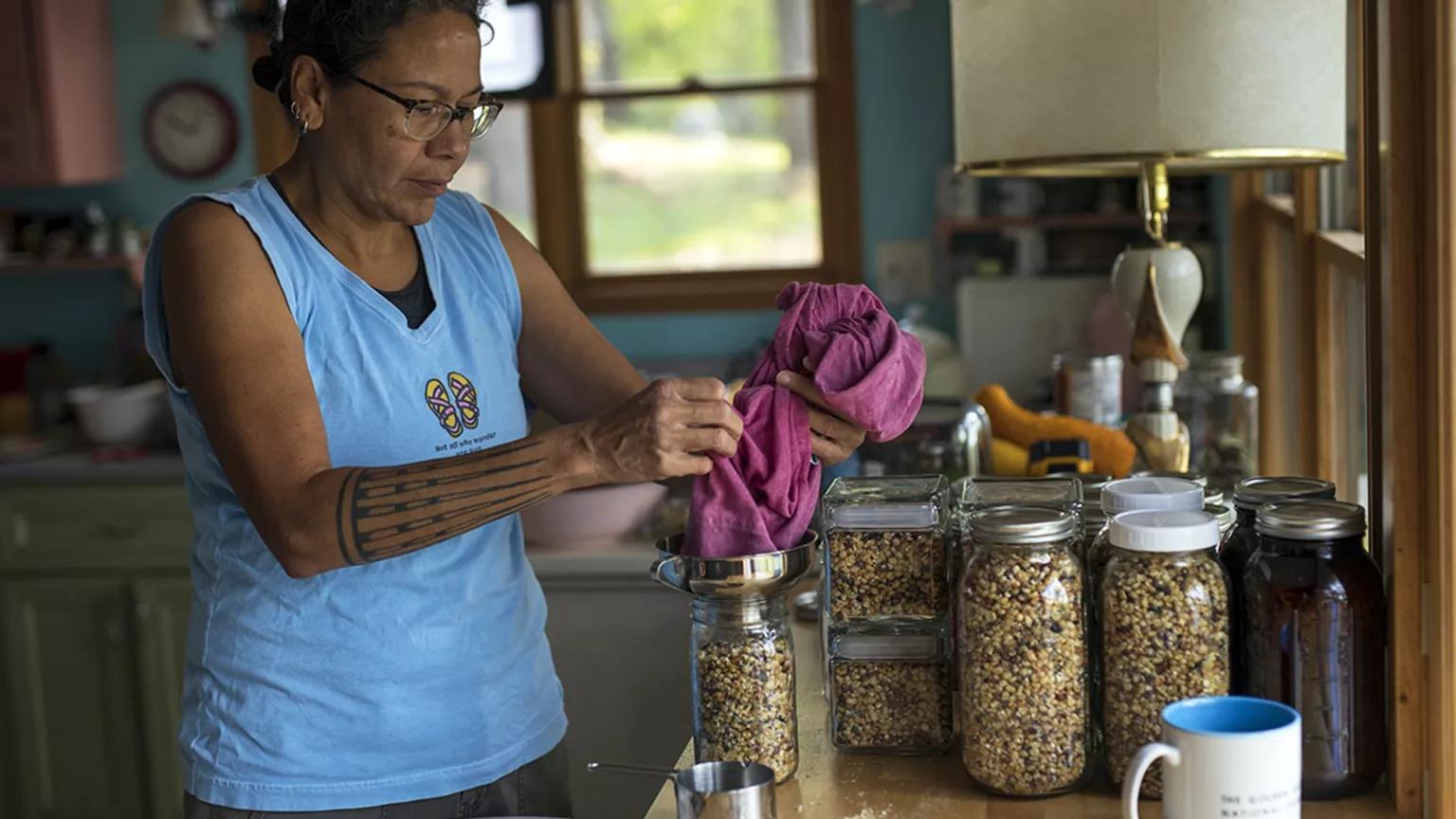
Shelley Buffalo, a member of the Meskwaki tribe, sifting Tama Flint corn into a jar
Courtesy of Cale Stelken
The smell of campfire wafts through the air at the Meskwaki settlement in central Iowa, as a giant pot of corn soup simmers above open flames and smoldering gray ashes. It’s the Tuesday after Indigenous Peoples’ Day, and the Meskwaki Food Sovereignty Initiative (MFSI) is hosting a grab-and-go lunch to celebrate the occasion. Tribal members mingle as they check out containers filled with fry bread, wa-bi-ko-ni (squash), and Tama Flint a-ta-mi-ni (corn).
Much of the produce offered is very locally grown, having sprouted in the Red Earth Garden just behind the packed picnic tables. Throughout the growing season, tribal members tend to crops in fields and greenhouses, then distribute the bounty to the community in boxes. In addition to tomatoes and kale, the farm yields some of the Meskwaki’s historic staples. Here, tendrils of bean plants curl around tall corn stalks, while squash vines snake through the ground below.
“I've always been told that the corn and the beans, and the squash, they're like our ancestors,” says Luke Kapayou, the ancestral farming manager at the settlement who has been keeping seeds since the 1990s. He explains that the crops, known as the three sisters, are “good friends with each other. They want to be planted together, they want to be grown together and be around each other. They want to be cooked together, and they want us to do it. . .The better you take care of them, the better they grow. And the happier they are.”
For thousands of years, the Meskwaki people have been eating a-ta-mi-ni. Their ancestors cultivated the corn variety by selecting plants that displayed desirable traits and crossing them with other well-performing plants. Once satisfied with the results, they would save the seeds the plant produced and pass them down, season after season, century after century. During the early 1900s, museums and other institutions began collecting seeds from Native Americans. “A lot of it was pretty underhanded and aggressive on the part of the white collectors,” says Meskwaki member Shelley Buffalo. They wanted, she says, “to get Native artifacts into the museums, because there was a universal expectation that the Indigenous People of the Americas would cease to exist.”
Tribes also gave seeds to groups that preserved them. In 1909, an ethnobotanist named William Jones, whose grandmother was Meskwaki, brought seeds from the tribe to the Field Museum in Chicago for preservation. The museum returned those seeds to the Meskwaki in 2019. Now other groups are also helping tribes get those heirloom seeds back to the communities that once cared for, grew, and saved them—an effort some call “rematriation,” in acknowledgement that tribal seed savers were traditionally women.
Buffalo worked for MFSI before becoming a seasonal seed saver at Seed Savers Exchange, an organization that has been preserving America’s heirloom plant varieties since 1975 and recently began returning seeds cultivated by tribes to Native growers. At the lunch table, Buffalo gestures to the steaming soup and piles of corn. “What you see here represents a legacy,” she says. “It is unique and pretty dear to us.”
Saving seeds helps that cultural legacy to live on, not only in traditional planting and culinary practices and ceremonies but also in the forms of food sovereignty and healthy bodies. And those same seeds also contain a genetic legacy—traits that allow plants to thrive without the artificial inputs of toxic chemicals and a diversity of genes that could help them, and us, survive the climate crisis.
A Century of Disruption
Since the dawn of agriculture more than 10,000 years ago, humans have been promoting their survival and their culture through farming. And it all started with seeds. In societies all over the world, growers thrashed and winnowed these tiny kernels from their protective envelopes and placed them in the earth, anxiously awaiting for sun-seeking shoots to poke through the soil. The plants that emerged usually thrived in specific conditions or geographic locations, and farmers chose to keep the seeds that gave them the most return on their investment, in the forms of plant hardiness, size, or flavor. Meskwaki growers, for instance, harvest seeds from the plants with the longest ears of corn, the plumpest kernels, or the most vibrant shades of yellow, red, or purple.
Up until the past two centuries or so, seed saving was the norm in Native American communities, and many had dedicated members tasked with passing seeds from one generation to the next. Those seeds, in essence, represent the intellectual property of tribes that grew and cultivated them. With the passing of the 1830 Indian Removal Act, however, the U.S. government began forcing tens of thousands of Native Americans off their lands. Many elders didn’t survive the mandated migrations, and older seed keepers often died before passing down their knowledge.
In 1845, the Meskwaki were forced to move hundreds of miles southwest to Kansas. In this new land, the tribe had to adjust their agricultural practices since their traditional crop varieties weren’t adapted to the local soils and climate. Though they continued to keep seeds, fewer people were planting them. The Meskwaki returned to Iowa in 1857—marking the first time a Native American tribe purchased land since the Indian Removal Act. The land in Iowa, however, was primarily forest, leaving little land for planting. Some Meskwaki worked on nearby white-owned farms, and others grew crops wherever white settlers allowed it. The community continued to cultivate small plots of corn, beans, and squash in the spring and summer, but overall, the Meskwaki were farming less than they had prior to displacement.
By 1850, the country’s first regional corn and wheat belts began to develop, and soon after, the U.S. agricultural industry began its own transformation. Over the following century, industrial agriculture has pushed farmers to grow crops in ever greater quantities: cheaper, more plentiful food but at great costs to the environment, public health, and culture.
In 1980, Congress passed the Bayh-Dole Act, which allows private entities to patent inventions developed under research programs funded by the federal government. This includes seed-breeding programs. As a result, companies began producing easy-to-grow seeds that produce higher yields and more uniform crops across a field. Yet the seeds could only provide such results for a single generation of plants, forcing farmers to buy new seeds every year. Company profits soared.
More and more seed companies formed and grew larger, with agronomists breeding plants that could withstand showers of dangerous pesticides and herbicides, such as glufosinate, glyphosate, and 2,4-D. Crops stayed green while weeds withered and beneficial insects—such as bees, butterflies, and other pollinators—died. The consequences to public health have also been significant. Certain pesticides, in certain doses, can irritate not only skin and eyes but are also linked to neurological problems and cancer. As chemical-laden monocultures covered the land and companies like Bayer and Monsanto expanded and merged, the seed pool continued to shrink. By 2019, just four companies owned 60 percent of the world’s seed market. Most Americans today are accustomed to eating one type of corn, one kind of potato, and one color of carrot.
“The average consumer doesn't realize all the biodiversity that existed in different crops and how little there is in comparison to what there was 80 years ago,” says Alexandra Zamecnik, director of Native Seeds/SEARCH, a nonprofit that has been saving and distributing seed adapted to the arid Southwest since 1983. The group houses the country’s largest collection of Native seeds.
Similar missions to keep seed lines and traditions alive have been growing in popularity. With the next generation of the seed-saving movement now blossoming, some organizations are freezing and keeping seeds in banks for later use. Others cultivate seed catalogues and promote growing plants and harvesting the seeds year after year. A number of these groups are now fostering deeper relationships with tribes, thanks, in part, to organizations like the Indigenous Seed Keepers Network. Through seed-saving, tribes and other BIPOC groups are nurturing connections to their cultures while simultaneously selecting crops that stand better chances against rising temperatures and shifting weather patterns.
Maintaining richer seed biodiversity allows us to keep crops that are already adapted to extreme conditions while simultaneously giving plants a better shot at adapting further if needed. Ultimately, this would improve our food security. For example, deep-purple Hopi blue corn—one of the 2,000 seed types in the Native Seeds/SEARCH collection—is more drought-tolerant than many other corn varieties. Nambe white corn thrives at 6,000 feet, and Rarámuri Gileno corn does well in high desert ecosystems. Santo Domingo chiles mature early, making them less susceptible to adverse weather events later in the growing season. Bachi Kajera squash grows in a low-elevation forest zone, while the San Juan Pueblo cushaw has shown a resistance to squash bugs.
“We've got a wonderful resurgence of Indigenous People who are farming,” says Karen Reichhardt, one of the founding members of Native Seeds/SEARCH. “They're honoring and respecting the seed, the origins of the seed, and planning for the future.”
“Connecting to Life”
Earth began when Sky Woman fell through a hole in the sky. Birds caught her, and the animals below collected mud from the seafloor and placed it on the back of a giant turtle, giving Sky Woman a safe place to land. As she followed the sun, walking east to west, Sky Woman formed Turtle Island, or North America. She had a daughter who later died, and in the place where Sky Woman buried her, plants began to grow that would sustain the Haudenosaunee people.
The creation story for the Haudenosaunee Iroquois Confederacy—a union of six nations that once spanned across much of the Northeast to the Great Lakes and into Canada—is part of many lessons seed keeper Stephen Silverbear McComber teaches his pupils. Since the 1970s, he’s been traveling around North America conducting seed exchanges and spreading the word about the important role seeds play in his people’s physical and spiritual sustenance. “A big part of our culture is agriculture,” says McComber.
Though his travel has slowed in recent years—and stopped completely once the COVID-19 pandemic hit—McComber still speaks to groups and individuals around the continent over Zoom. Closer to home, on a four-acre community garden outside Montreal, he mentors high school students and teaches Haudenosaunee people the traditional farming practices he learned from his grandmother, such as how to plant squash and potatoes with the cycles of the moon. The garden proved to be so popular that, with the help of his community, McComber quadrupled its size this year.
“Seeds are a living thing, and we are a part of a living universe,” he says. “We can, all of us, have this opportunity to put our hands into the soil, and all of us have the opportunity to connect to life.”
A few years ago and on the other side of the continent, Tudor Montague, a member of the Quechan tribe, was living in Phoenix, planting tomatoes and peppers in his garden, when a friend told him about Native Seed/SEARCH. When looking into the group, Montague was struck by the varieties available from where he grew up on the Fort Yuma reservation. “The fact that they had these historically traditional varieties available just kind of blew my mind,” he says.
Moving back to the reservation a year later, Montague started a coffee-roasting business and began planting melon, corn, and tepary beans in his backyard. “I'm growing these seeds out in the exact area that they're from,” he says. “So I was able to kind of reconnect with the seeds that have a traditional connection to my people.”
It wasn’t long before Montague joined the board of directors of Native Seed/SEARCH, and last year after harvest, he sent the resulting seeds back to the group so it could offer them to others. “Not only personally can I grow these out and supplement my food with the crops, but we can maybe spread this to my community,” Montague says, adding that he hopes to start a garden next year, where more Quechan members can participate.
The efforts of McComber, Montague, and countless other Indigenous growers are helping to inspire other BIPOC communities who are also busy collecting, growing, and sharing plants not typically available in hardware stores or seed catalogues. Increased access to heirloom seeds not only lessens reliance on expensive specialty grocery stores but also helps disenfranchised groups continue traditions or start new ones. Meanwhile, their gardens contribute to plant and animal diversity and, potentially, a more climate-resilient food supply.
While working for an heirloom seed saver in Philadelphia named William Woys Weaver, Owen Taylor and his husband, Chris Bolden-Newsome, co-founder of Sankofa Community Farm at Bartram’s Garden, were invited to join the now defunct Seed Keepers Collective in which the majority of members were Black. Some members had recently attended the White Earth Indigenous Farming Conference, held every year in Minnesota, where Native people discuss traditional foods, sustainable practices, and opportunities for collaboration.
They started having “all these conversations with people who were in the food justice movement, primarily Black farmers, talking about what it would mean to save and keep our community heirlooms,” says Taylor. “I was like, ‘Wow, this is where I want to be spending my energy.’” In 2016, he and Bolden-Newsome created Truelove Seeds, a small company that sells culturally important vegetable, herb, and flower seeds.
A self-described plant nerd, Taylor offers workshops to people interested in harvesting and saving seeds, teaching seed preparation courses to a host of groups, including Burmese refugees, both online and in person. He shows people how to harvest seeds from tomatoes, cucumbers, and eggplant, and how to ferment the seeds to get the protective goop off, dry, and store them. When plants from the mint family are ready for harvest, Taylor demonstrates how to cut the whole stalk, dry it out, wrap it up in a tarp, and whack it so the seeds tumble out, a process called threshing.
Working with 50 farming groups, Truelove splits its profits 50-50 between the company and the group or person who provided the seeds. Sales spiked last year as people took up gardening during the pandemic, but Taylor expects consistent growth as Truelove Seeds expands its offerings, including plants like the Peruvian huacatay, an herb from the marigold family, and a leafy green called Egyptian spinach.
Luckily, one doesn't need a green thumb to enjoy the benefits from heirloom seeds. There are plenty of companies and restaurants ready to serve up new-to-you flavors and biodiverse specialties. Barrio Bread, for instance, bakes with flour made from Sonoran wheat, a variety introduced to the Southwest by Jesuit priests who needed it to make their communion wafers. Today, company owner Don Guerra acquires the wheat from Arizona farmers who get their seeds from Native Seeds/SEARCH and who are recipients of a grant from Sustainable Agriculture Research and Education, a program that supports research by local farmers in every U.S. state and island protectorate—and one that needs more federal funding.
Guerra’s bread is exceptionally popular and celebrated for its local ties and sweet flavor. A local brewer also uses Sonoran wheat to make beer. By continuing to grow the wheat, these companies are giving the plant a chance to keep adapting to the challenging conditions of the Southwest and providing us with one more morsel of insurance in a warming world.
A Taste of the Future
Wedged into the side of a mountain on a remote, icy archipelago between Norway and the Arctic Circle sits the Svalbard Global Seed Vault. The so-called “Doomsday vault” is an international effort to preserve crop diversity, and last year, the Cherokee Nation became the first Native American tribe to contribute to the collection. The genetics of white eagle corn, candy roaster squash, and Cherokee Trail of Tears beans are now protected along with millions of other seeds from all over the earth.
When making the decision to send seeds to Svalbard, tribal elders discussed “the fickleness of time and politics and the realities of extreme weather,” says tribal biologist Pat Gwin. “We felt that our seeds would be stored not just in the scientifically proper way, but they would not be culturally disturbed.”
Each summer, the Cherokee grow their heirloom seeds in a six-acre demonstration garden in Tahlequah, Oklahoma. The tribe conducts daily garden tours during the growing season, and at harvest time, they send seeds to the tribe’s local seed bank as well as to community growers for the following year. Gwin distributes 5,000 orders of seeds and plants annually, and demand keeps rising. In 2020, when so many people took to their gardens, the tribe ran out of seeds just 32 hours after offering them online.
Saving the seeds helps preserve the crops’ genetic diversity and gets the tribal community involved, says Gwin, who created the garden in 2005. Whether placed within a Norwegian glacier or midwestern soil, the seeds are critical to maintaining future food supplies.
Seed saving has “never been more important than today, and it's getting more important by the day,” says Hannes Dempewolf, a senior scientist with Crop Trust, one of the organizations that manages the Svalbard vault. “That has to do with the loss of diversity from our food system,” he says.
Experts warn that as climate change threatens to disrupt global food supplies with more frequent waves of pests, diseases, and extreme weather, we need more crop alternatives, not fewer. Climate models predict that future summers in the Midwest, for instance, will be hotter and wetter. Iowa, home to the Meskwaki, is expected to receive an inch more rainfall every decade, and by 2050, the state’s average five-day heat wave could become 7 degrees Fahrenheit hotter, entering into triple-digit temperatures.
Monocultures are more vulnerable to those climatic changes. “You hear it in the news all the time,” says Christina Walters, a plant researcher at the U.S. Department of Agriculture in Fort Collins. “A freeze snap in Michigan that killed cherries, or a citrus disease that's wiping out the orange crop, or rust disease in the Midwest that's wiping out corn, or an aphid. I mean, there's always some kind of a problem. Our best defenses to any of those biotic or abiotic problems is through what has been developed over, well, millennia.”
On their settlement, the Meskwaki grow corn without irrigation or pesticides, and they still yielded 20 gallons of corn kernels last year from just a quarter-acre of land. The seeds from crops like these, “are incredibly wise and adaptive, and growing them out each season, they are adapting to climate change,” says Buffalo. “They have the ability because they have within their genetics a lot of diversity.”
In a shed down the road from the Red Earth Garden, a tractor sits in a shed until next season. Thanks to Buffalo’s efforts, community members plan to plow this land in order to give more recently used fields a break to allow the soil to recover. In the new plot, tribal members may even plant rematriated melon and bean seeds.
“My identity is Meskwaki,” says Buffalo as she looks over the settlement’s fields, so “eating those foods, growing those foods, keeping that seed has just done such a tremendous amount of healing for me personally.” In addition to precious genetic material, the seeds encapsulate a part of her people’s past as well as their future. Whether the food is for a holiday or a ceremony, she says, the bounty of their land and of centuries of labor, “tastes like home.”
This NRDC.org story is available for online republication by news media outlets or nonprofits under these conditions: The writer(s) must be credited with a byline; you must note prominently that the story was originally published by NRDC.org and link to the original; the story cannot be edited (beyond simple things such as grammar); you can’t resell the story in any form or grant republishing rights to other outlets; you can’t republish our material wholesale or automatically—you need to select stories individually; you can’t republish the photos or graphics on our site without specific permission; you should drop us a note to let us know when you’ve used one of our stories.
Forty percent of food in America is wasted.
Make smart decisions about using, storing, and buying food to help save the environment.

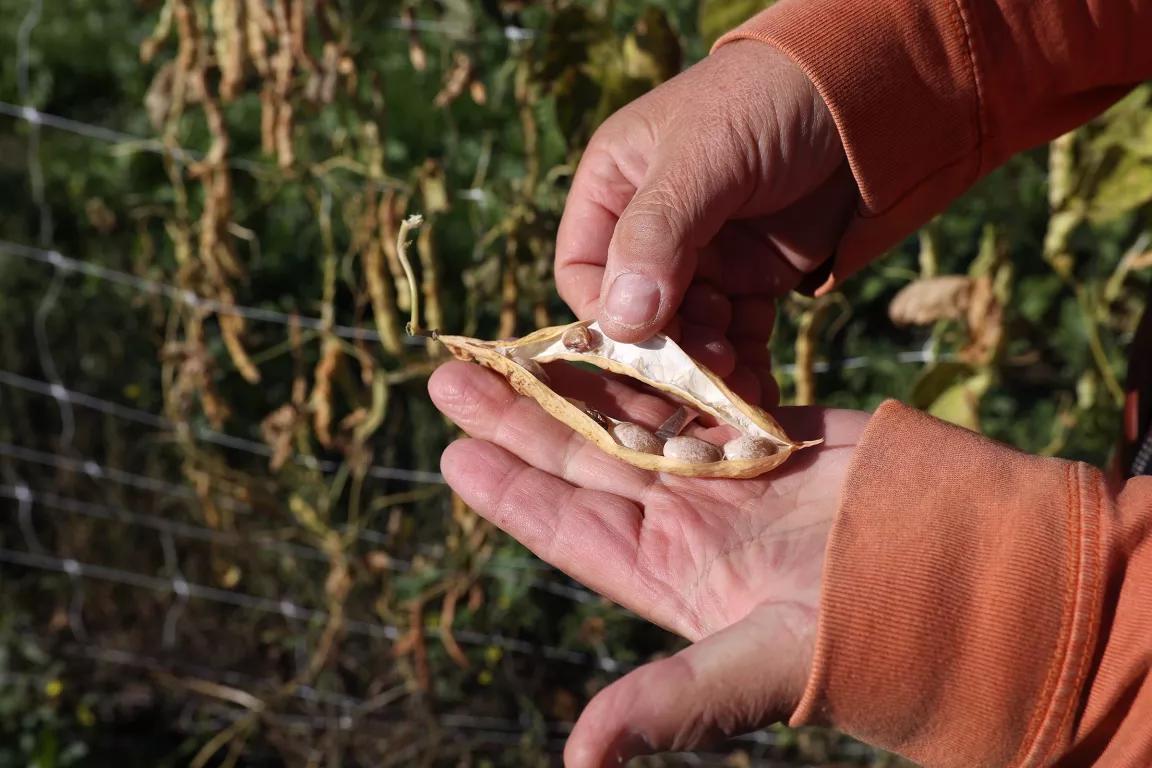
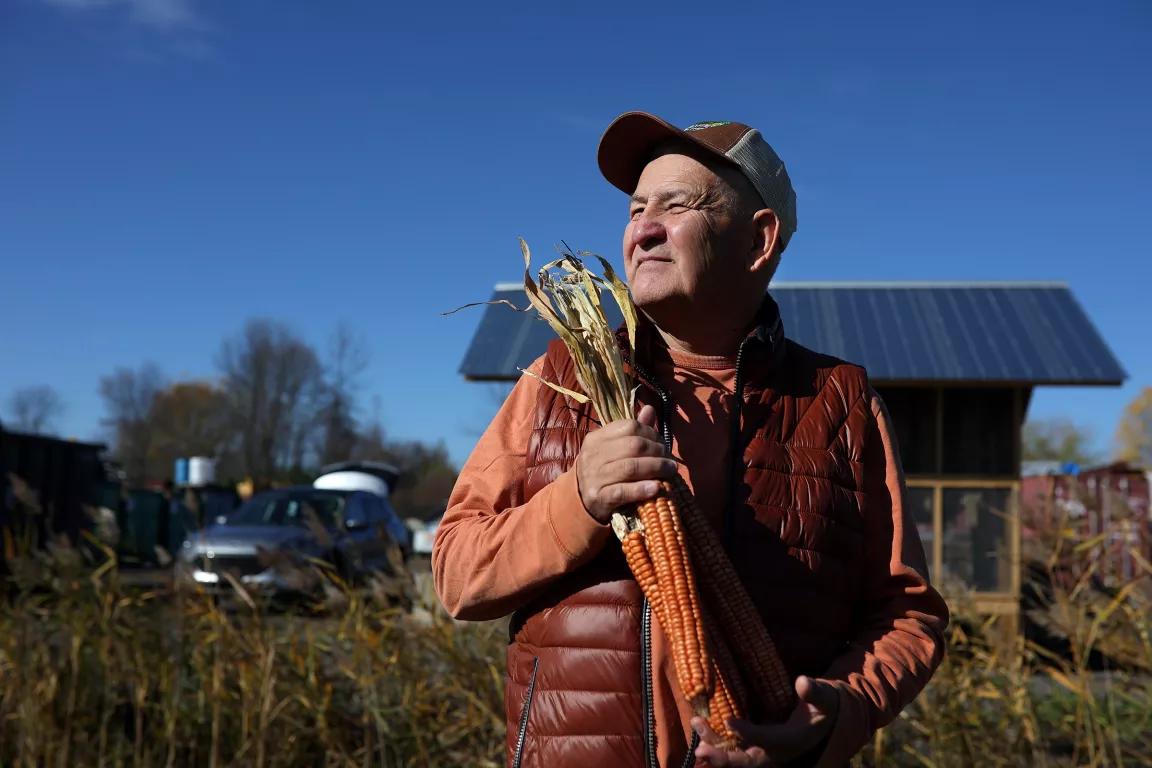

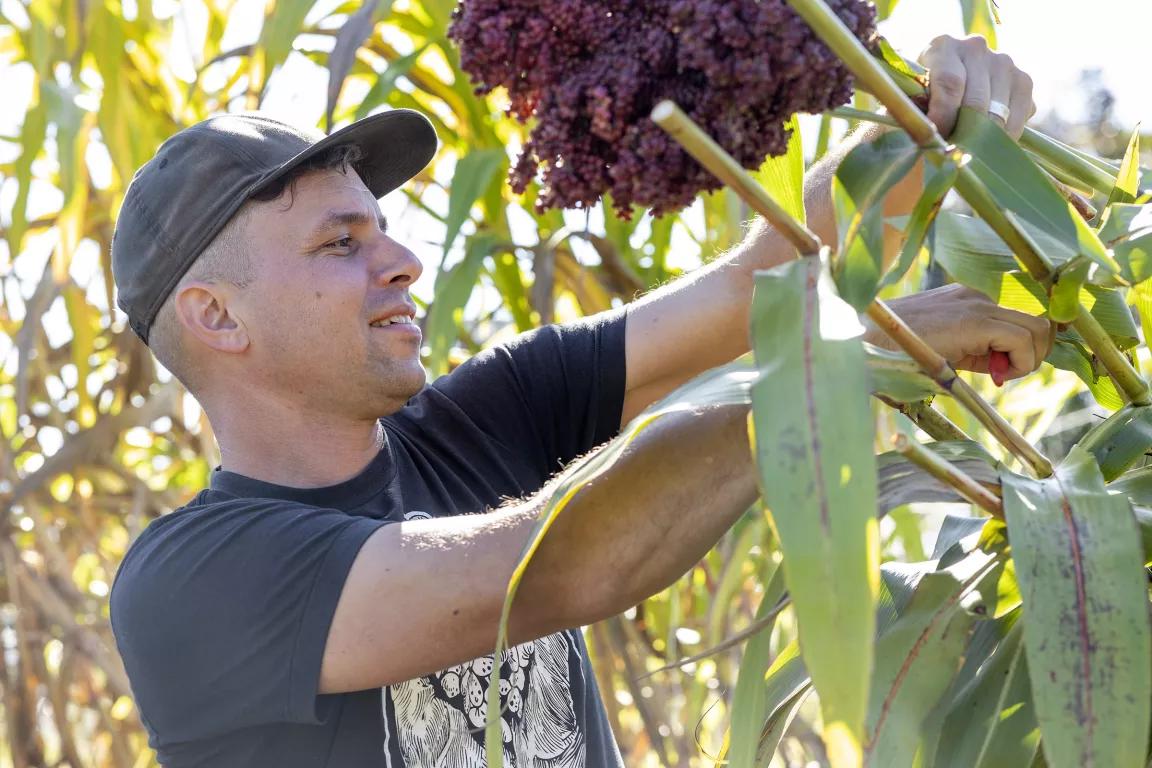
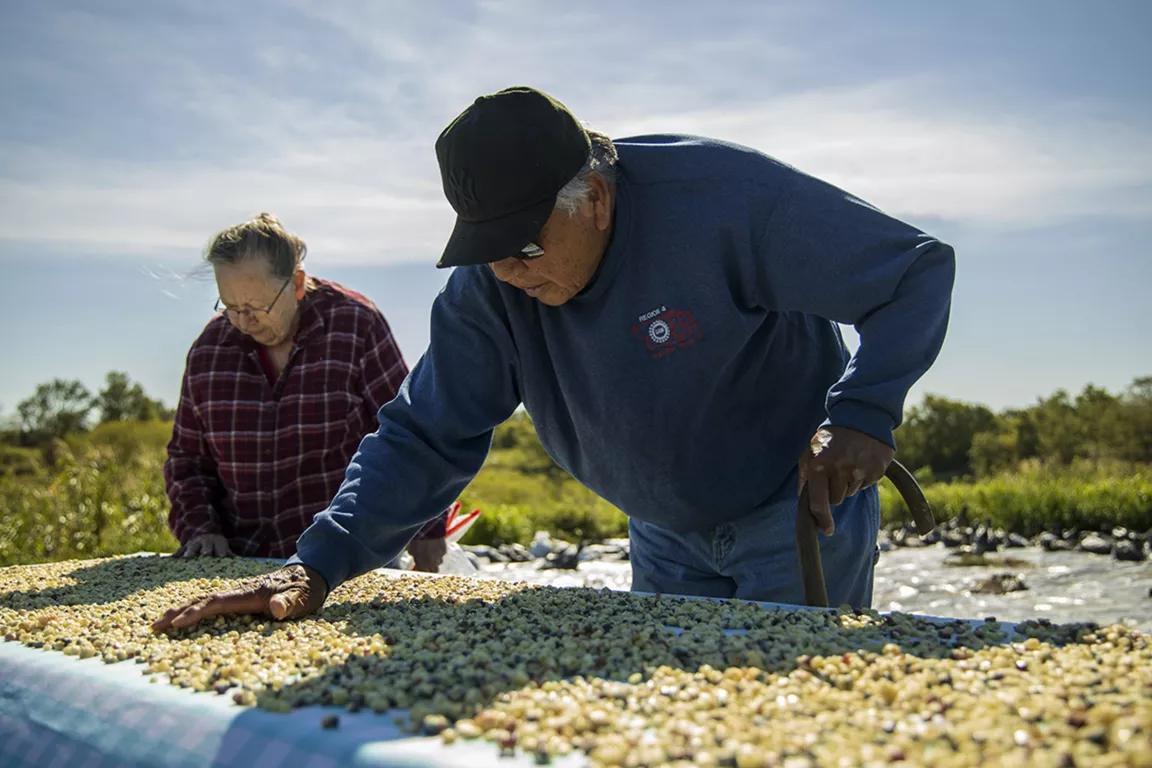
Three Ways We Can Make Schools Healthier This Year
Washington State Adds Emergency Rules to Protect Workers from Heat and Wildfire Smoke
Taking Care of the Food Workers Who Take Care of Us